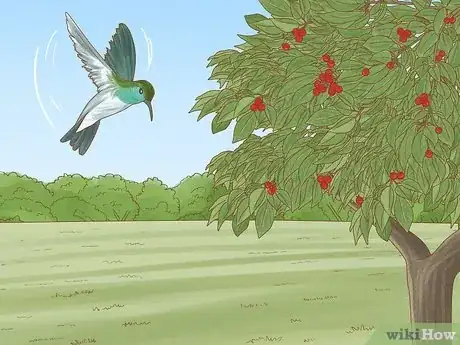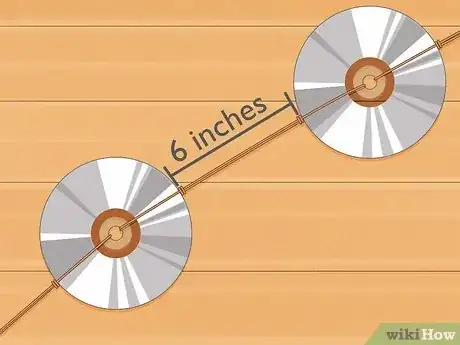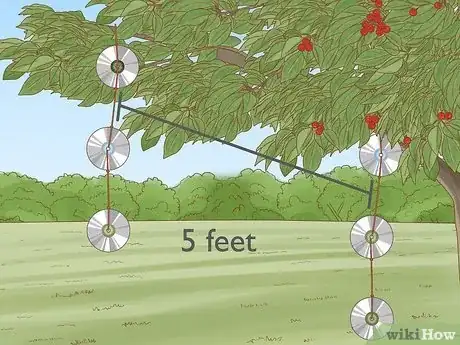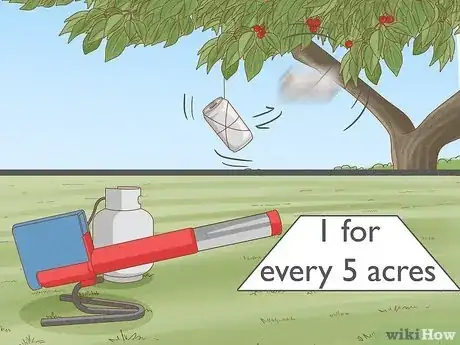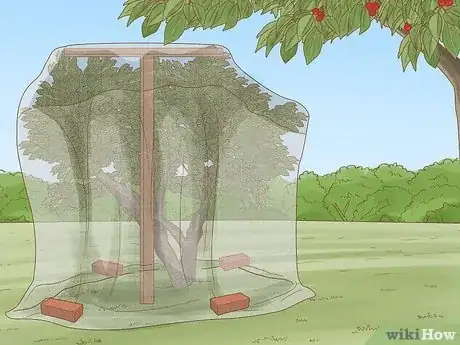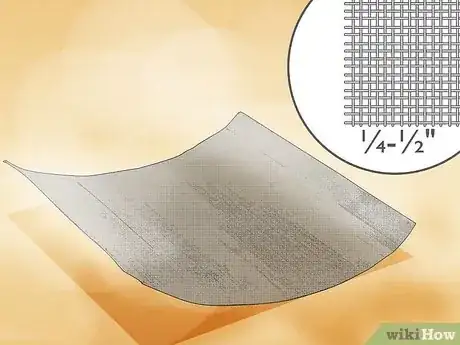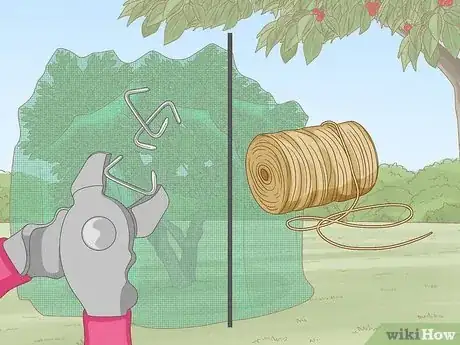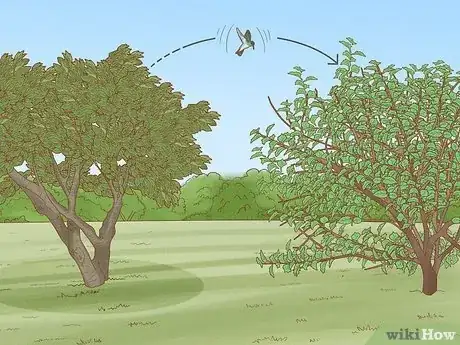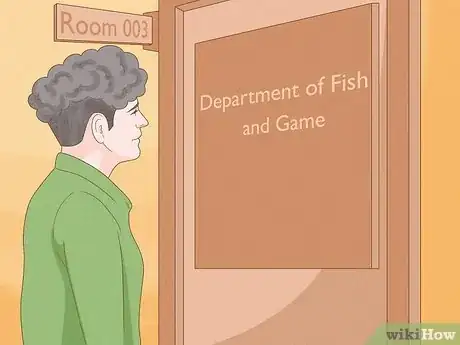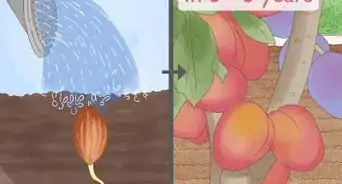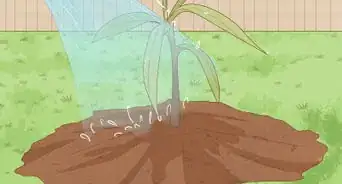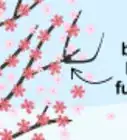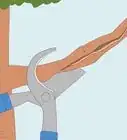This article was co-authored by Andrew Carberry, MPH. Andrew Carberry is a Food Systems Expert and the Senior Program Associate at the Wallace Centere at Winrock International in Little Rock, Arkansas. He has worked in food systems since 2008 and has experience working on farm-to-school projects, food safety programs, and working with local and state coalitions in Arkansas. He is a graduate of the College of William and Mary and holds a Masters degree in public health and nutrition from the University of Tennessee.
There are 7 references cited in this article, which can be found at the bottom of the page.
This article has been viewed 69,161 times.
Cherry trees are the pride of backyards and the livelihood of orchard growers. If you're not careful, all of your harvest can disappear in a few days. Fight back to keep the fruit out of the thieves' talons.
Steps
Scaring Birds Away
-
1Start when birds begin to show. Keep track of bird sightings in your garden or orchard, either with a formal count or by intuition. Once the number of birds starts to grow, and the fruit shows the first hint of color, it's time to protect the trees.[1]
- These scare tactics are very effective, but only last a few weeks.[2] Starting too early may leave your trees vulnerable later, once the birds are used to your tactics.
-
2Choose shiny objects. Pick exactly one of these proven ideas, or another bright object:
- Aluminum pie tins
- Scrunched up sheets of tin foil, coiled into a spring shape
- Old CDs or DVDs
- Strips of white cloth
- Mylar streamers
- "Scare eye" balloons
Advertisement -
3Tie them onto strings. Tie a string about 6 inches (15.2 cm) long to each object.
- If using CDs/DVDs, slip a second CD onto the string to sit on top of the first one.[3] This will sit at an angle, reflecting light upward.
-
4Hang them up around your tree. Tie the shiny objects onto the trees. Space them about 5 feet (1.5 m) apart, or just enough to be visible from every angle. Five or six should work for a small tree, but a large tree may need many more.
-
5Switch to other shiny objects periodically. Once birds learn that the objects are harmless, they'll start to eat your cherries again. The repellent tends to work longer for tart cherries or yellow cherries — sometimes a full season, if you're lucky. Birds will spend more effort for sweet red cherries.[4] To protect them, change the repellent every week or two.[5]
- For instance, put up CDs. When bird activity increases, replace them with foil springs. Replace again with aluminum pie tins, then return to CDs.
-
6Add noisemakers if necessary. Commercial orchards often add scary noisemakers as well. This is more effective than visual repellents alone, but birds still get used to them. When birds start to approach again, replace either the visual repellent or the noisemaker.
- If you only have a couple trees, just hang aluminum cans or other clusters of noisy objects. Anything louder may not be worth the annoyance in a home garden.
- The cheapest commercial devices are handheld noisemakers that fire a small, loud explosive. These require frequent patrols.
- To save labor, buy a stationary gas cannon or electric distress signal. Place these above the canopy, one for every 5 acres (2000 square meters).[6]
Covering Trees with Netting
-
1Try this for small to medium trees only. Before you buy your netting, make sure you can drape it over the tree. Trees more than 8 feet (2.4m) tall are impractical to cover. For trees near this height, use ladders and/or a device that can lift the netting on a tall pole, then drape it outward.
-
2
-
3Cover the entire tree. This part can be a pain, and requires at least two people for most trees. Wait until your cherries have formed, then cover the tree once you see them starting to take on green color. The netting will catch against the branches, so hold the netting flat above the tree and lower it. It should cover the entire tree, and hang fairly loosely, since cherries tight against the netting will still get eaten.
-
4Secure the netting at the base. Birds can fly underneath the netting and get trapped. To prevent this, tie the base of the netting securely to the base of the tree with twine or hog rings.
- You can also stake the netting down to the ground around the drip line of the tree.
Other Methods
-
1Plant mulberry trees. Fruit-eating birds love mulberry trees. Plant a female mulberry tree nearby, from a variety that fruits just before the cherry trees. The birds should flock to the mulberry tree much more than the cherries, as long as the tree still has fruit.
- Avoid the mulberry variety Illinois Everbearing, which have slow-ripening fruit too large for many birds.[11]
-
2Get approval for shooting or trapping. Some orchard growers shoot larger cherry thieves such as jays and magpies, and/or trap starlings and other small birds. You may need government approval.[12]
- In the US, contact the Department of Fish and Game or the local Agriculture Commissioner. In the UK, contact Wildlife Management.
- Local university agriculture extensions can teach you how to choose and set traps. Traps are much more effective when matched to your bird population and set by an expert.
Community Q&A
-
QuestionIs netting habitat modification?
 Community AnswerYes, as it modifies the habitat. Be careful when netting as it can be dangerous to birds.
Community AnswerYes, as it modifies the habitat. Be careful when netting as it can be dangerous to birds.
Things You'll Need
- Tin foil
- String
- Bird netting
- A ladder
- A long pole
- Stakes
References
- ↑ http://www.ipm.ucdavis.edu/PMG/C105/m105yi01.html
- ↑ http://www.ipm.ucdavis.edu/PMG/r105600111.html
- ↑ https://www.youtube.com/watch?v=vPOaVh5Y2UI
- ↑ http://www.garden.org/foodguide/browse/fruit/cherry/1456
- ↑ http://www.ipm.ucdavis.edu/PMG/r105600111.html
- ↑ http://www.ipm.ucdavis.edu/PMG/r105600111.html
- ↑ http://www.motherearthnews.com/organic-gardening/pest-control/how-to-protect-fruit-from-birds-zm0z15amzkin.aspx
- ↑ https://www.ehp.qld.gov.au/wildlife/livingwith/flyingfoxes/netting_fruit_trees.html
- ↑ http://forums.gardenweb.com/discussions/1470341/when-to-net-cherry-trees
About This Article
If you’re worried about birds eating your cherry trees, there are a few things you can do to keep them away. Try hanging shiny items on the outside of your trees, like old CDs, aluminum pie tins, and scrunched up sheets of tin foil. Hang them from string about 5 feet apart to keep birds away. Keep in mind that after a few weeks, the birds might realize the objects aren’t a threat and start to eat your cherry trees again. To combat this, replace the objects on your tree every few weeks. Alternatively, if your trees are small or medium-sized, cover them with fine-mesh netting. You’ll need someone to help you cover the tree and secure the base of the net to the tree, but this can keep birds away indefinitely. For more tips from our Agricultural co-author, including how to add noisemakers to your cherry trees to deter birds, read on!
